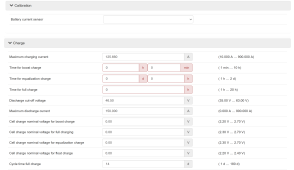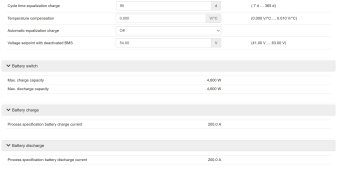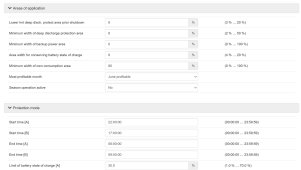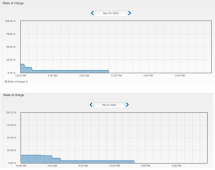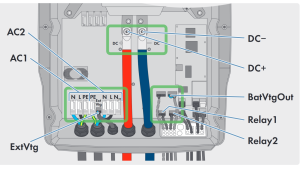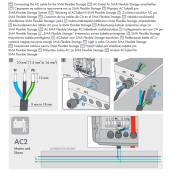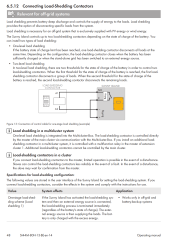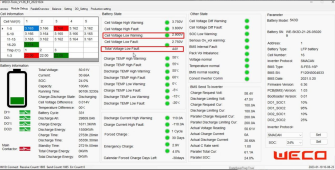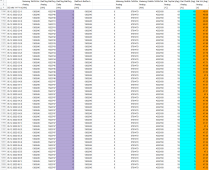mike01
New Member
- Joined
- Dec 27, 2022
- Messages
- 8
Hi,
I have a residential solar+storage system.
The house is permanently AC grid supplied.
I have a Sunny Boy 4 with 4.5kW of solar panels.
I have 2x Weco 5K3 LiFePO4 batteries (5.3kw each) attached in parallel (48v) to an SMA Sunny Island 8.0H-13 inverter for storage/own consumption in AC.
As I have a stable grid supply, the SI is not providing backup function.
The Weco batteries were setup for SMA CAN communication (they're not on the SMA supported list but Weco supports the SMA CAN protocol).
CAN communication works (closed loop) and for the majority of time the system and batteries work OK.
The problem:
The Sunny Island is configured to stop discharging the batteries when SoC reaches 20%.
However, every 2 weeks (varies a bit) the Sunny Island goes mad and discharges the batteries to the critical level (5%), BMS protection kicks in and then the whole thing shuts down - SI will not restart charging.
Some images below illustrate this (here a link to the Sunny Island 5 minute log if anyone can have a look at it):

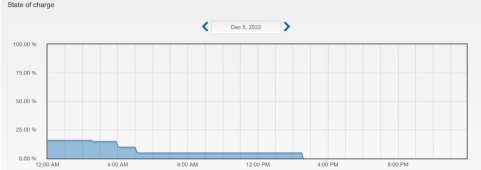
Once the batteries are at 5%, a manual charge of the batteries with a portable 48v charger is required to restart operation.
Somehow the batteries are being drained below the SoC limit in the configuration right up to the shutdown limit.
The installer has tried several settings on the SI but this issue continues to occur.
It seems they have no additional ideas to try and tell me it's a known Sunny Island "AC coupling" issue that can only be solved by wiring 1 solar panel directly to the batteries so that if they are discharged then the panel will bring them back online...
- What could be the reason for the inverter continuing to drain the batteries below its configured SoC limit?
- Any other ideas that could help eliminate this problem?
- Could you share the recommended LiFePO4 battery parameters for the setup of the 5k3 with Sunny Island (in Lithium / closed-loop mode)?
Thanks in advance for your support, happy to provide any additional info, BR!
I have a residential solar+storage system.
The house is permanently AC grid supplied.
I have a Sunny Boy 4 with 4.5kW of solar panels.
I have 2x Weco 5K3 LiFePO4 batteries (5.3kw each) attached in parallel (48v) to an SMA Sunny Island 8.0H-13 inverter for storage/own consumption in AC.
As I have a stable grid supply, the SI is not providing backup function.
The Weco batteries were setup for SMA CAN communication (they're not on the SMA supported list but Weco supports the SMA CAN protocol).
CAN communication works (closed loop) and for the majority of time the system and batteries work OK.
The problem:
The Sunny Island is configured to stop discharging the batteries when SoC reaches 20%.
However, every 2 weeks (varies a bit) the Sunny Island goes mad and discharges the batteries to the critical level (5%), BMS protection kicks in and then the whole thing shuts down - SI will not restart charging.
Some images below illustrate this (here a link to the Sunny Island 5 minute log if anyone can have a look at it):


Once the batteries are at 5%, a manual charge of the batteries with a portable 48v charger is required to restart operation.
Somehow the batteries are being drained below the SoC limit in the configuration right up to the shutdown limit.
The installer has tried several settings on the SI but this issue continues to occur.
It seems they have no additional ideas to try and tell me it's a known Sunny Island "AC coupling" issue that can only be solved by wiring 1 solar panel directly to the batteries so that if they are discharged then the panel will bring them back online...
- What could be the reason for the inverter continuing to drain the batteries below its configured SoC limit?
- Any other ideas that could help eliminate this problem?
- Could you share the recommended LiFePO4 battery parameters for the setup of the 5k3 with Sunny Island (in Lithium / closed-loop mode)?
Thanks in advance for your support, happy to provide any additional info, BR!




